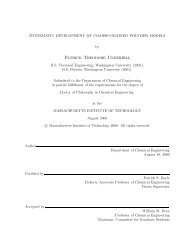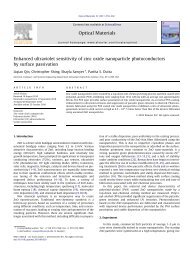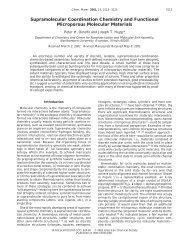Branch-and-Cut Algorithms for Combinatorial Optimization ...
Branch-and-Cut Algorithms for Combinatorial Optimization ...
Branch-and-Cut Algorithms for Combinatorial Optimization ...
Create successful ePaper yourself
Turn your PDF publications into a flip-book with our unique Google optimized e-Paper software.
to eliminate variables (§5.1), working with a subset of the variables <strong>and</strong> then<br />
adding in the omitted variables later if necessary (§5.2), using primal heuristics<br />
to generate good solutions so that nodes can be pruned by bounds (§5.3),<br />
preprocessing the problem (§5.4), maintaining an appropriate balance between<br />
cutting <strong>and</strong> branching (§5.5), <strong>and</strong> strengthening cuts through lifting (§5.6). Further<br />
details are discussed in §5.7 <strong>and</strong> the possibility of using an interior point<br />
method to solve the linear programming relaxations is discussed in §5.8.<br />
5.1 Fixing variables<br />
Nonbasic variables can be guaranteed to take their current values in an optimal<br />
solution to the integer programming problem if their reduced costs are sufficiently<br />
large. For example, if the binary variable xj equals zero in the optimal<br />
solution to an LP relaxation <strong>and</strong> the reduced cost of this variable is rj, thenany<br />
feasible point in the relaxation with xj = 1 must have value at least z+rj, where<br />
z is the optimal value of the relaxation. The value ¯z of the best known feasible<br />
integral solution provides an upper bound on the optimal value of the integer<br />
program, so we must have xj =0ifrj > ¯z − z. Similar tests can be derived<br />
<strong>for</strong> nonbasic variables at their upper bounds. It is also possible to fix variables<br />
when an interior point method is used to solve the relaxations (Mitchell et al.,<br />
1998).<br />
Once some variables have been fixed in this manner, it is often possible to fix<br />
further variables using logical implications. For example, in a traveling salesman<br />
problem, if xe has been set equal to one <strong>for</strong> two edges incident to a particular<br />
vertex, then all other edges incident to that vertex can have their values fixed<br />
to zero.<br />
In order to fully exploit the fixing of variables within the branching process,<br />
parent node reconstruction (Padberg <strong>and</strong> Rinaldi, 1991) is per<strong>for</strong>med as follows.<br />
Once a parent node has been selected, it is not immediately divided into two<br />
children, but is solved again using the cutting plane algorithm. When the<br />
cutting plane procedure terminates, the optimal reduced cost vector has been<br />
reconstructed <strong>and</strong> this is used to per<strong>for</strong>m variable fixing.<br />
5.2 Column generation<br />
For many problems, including the traveling salesman problem, it is impractical<br />
to work explicitly with all the variables. Thus, the typical approach <strong>for</strong> the<br />
TSP is to find the ten (say) closest neighbours <strong>for</strong> each vertex <strong>and</strong> work only<br />
with the corresponding edges. In order to verify optimality, it is necessary to<br />
check at the end that none of the omitted edges are actually necessary. In linear<br />
programming terms, this requires checking whether a column should be added<br />
to the relaxation corresponding to the omitted variable. The reduced cost of<br />
this column can be found from the values of the dual variables: the column<br />
should be added if the extra dual constraint would be violated by the optimal<br />
dual solution to the current relaxation. If a large number of columns need to<br />
14







